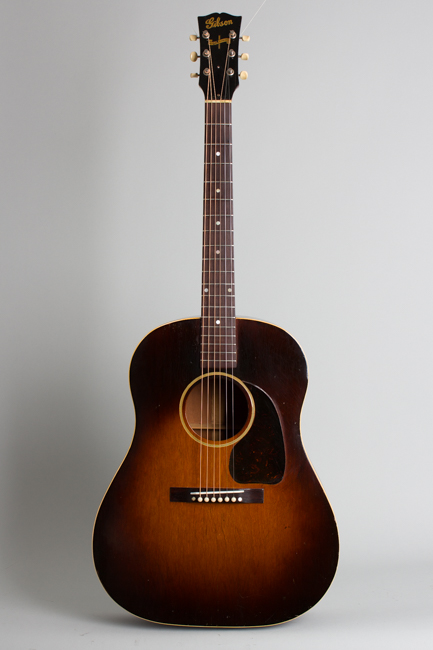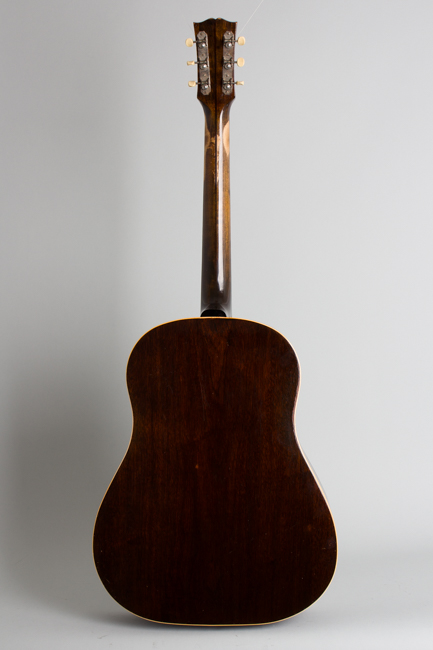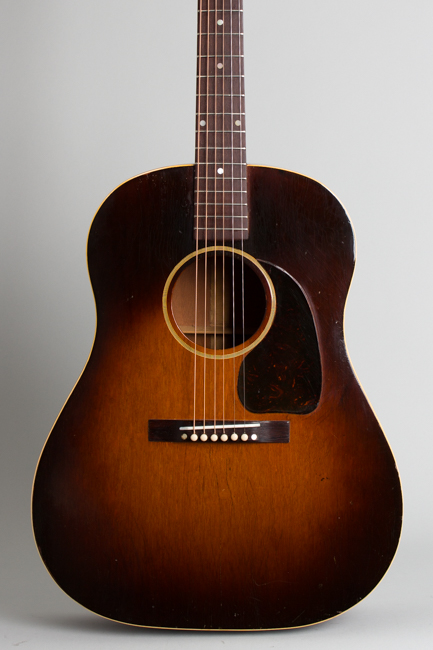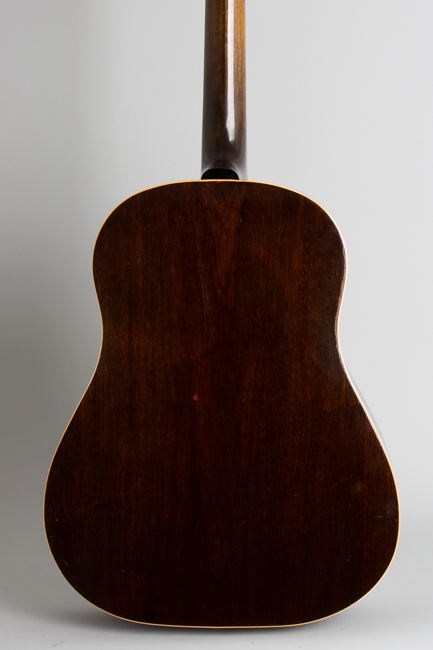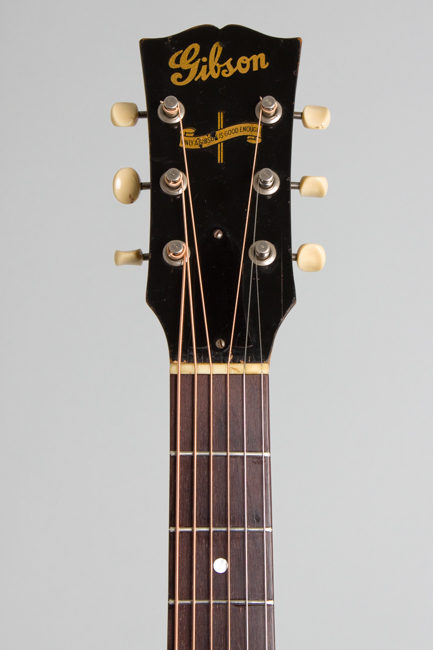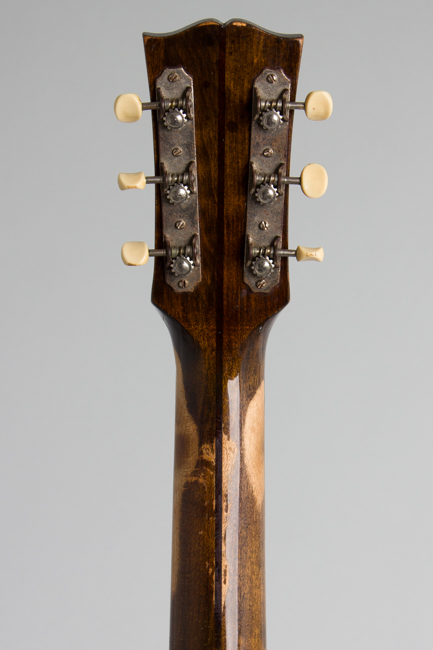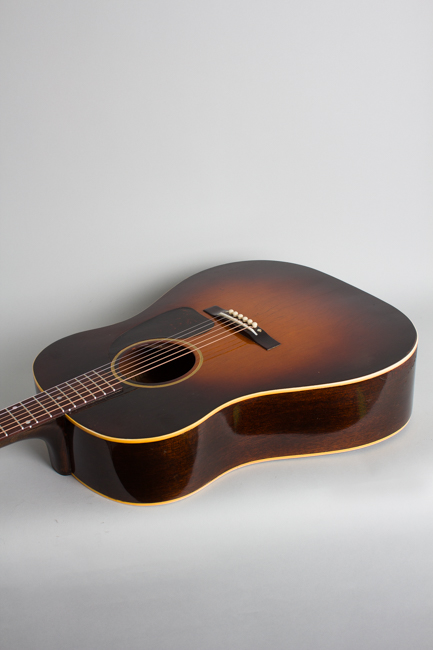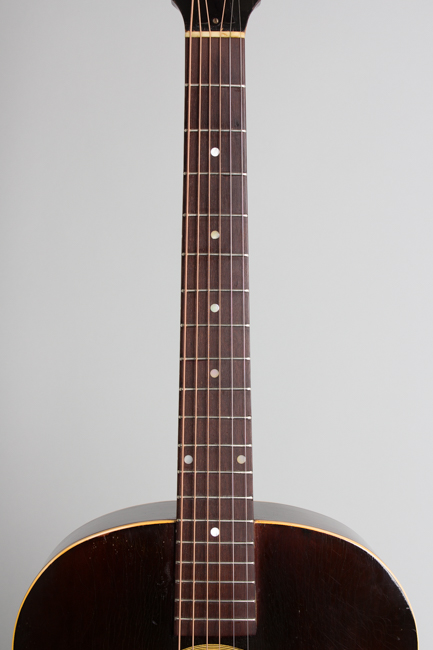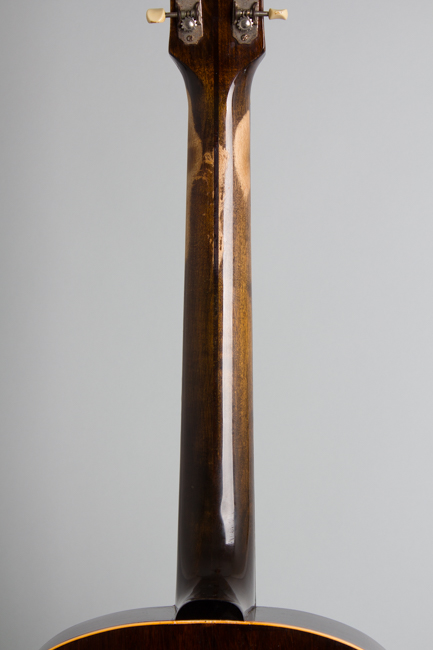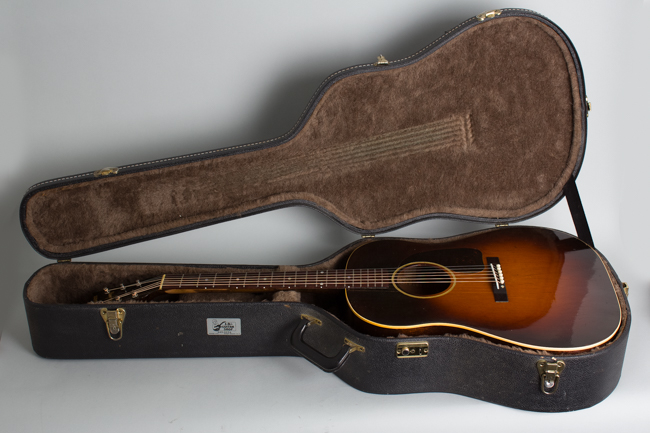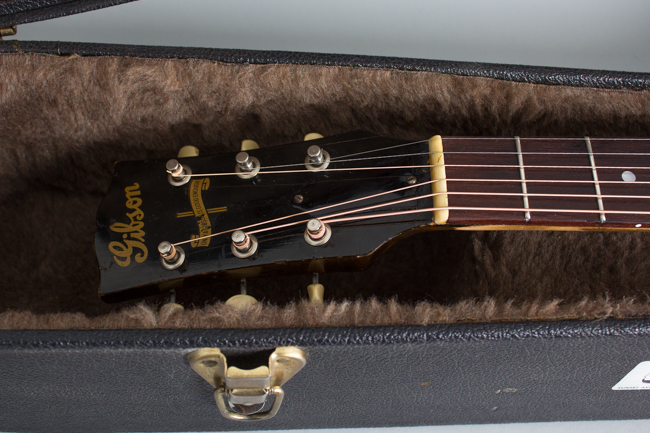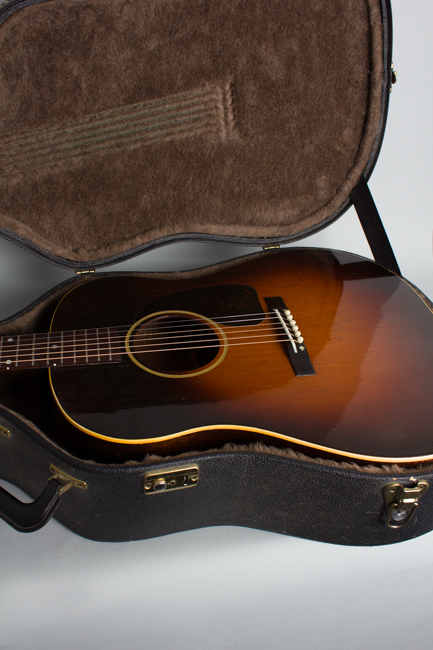Gibson J-45 Banner Flat Top Acoustic Guitar (1943)
Gibson J-45 Banner Model Flat Top Acoustic Guitar (1943), made in Kalamazoo, Michigan, serial # 2656-13, sunburst top, dark back and sides finish, mahogany body, laminated maple neck with rosewood fingerboard, black tolex hard shell case.
This is a cool and great playing example of a "Banner" Gibson J-45 -- so called for the decal on the headstock reading "Only a Gibson Is Good Enough" used only during WWII. The J-45 was one of the few Gibson models in full production during the Second World War when the company's instrument output was severely limited. In this period the specifications of individual instruments often vary greatly from published standards; Gibson ran short of many materials and struggled under wartime restrictions. The widely variant features were dictated by the materials available; this particular guitar has the unusual combination of a mahogany back and sides with a sunburst-finished mahogany top (instead of the normal spruce) and a 3-piece laminated maple neck. These latter two give the guitar a noticeable different feel and sound from the "standard" J-45.
This guitar is also somewhat unusual in retaining the standard adjustable truss rod, a feature often deleted from wartime models as metal was severely rationed. The tuners are the slim flat-plate riveted Klusons of the period, specifically designed to use the minimum of metal possible. The top and back are single bound with a 7-ply soundhole ring and tortoise Celluloid pickguard. The Factory Order Number (FON) 2656-13 on the heelblock identifies this guitar as a 1943 (or possibly 1944) model, based on recent research.
The maple neck's profile is round and chunky, quite deep but still not as thick feeling as some wartime Gibsons. The individual features are typical of other guitars built in this period, but the specific combination of a mahogany top, maple neck AND the adjustable truss rod is a fairly rare find. This is a great-sounding guitar with a huge tone despite, or more likely because of, its unusual combination of woods. This particular "Banner" has had some repair work but remains in better condition than many of these both structurally and cosmetically. This is an excellent players' guitar as well as a rare and interesting J-45 variant.
Overall length is 40 1/2 in. (102.9 cm.), 16 in. (40.6 cm.) wide at lower bout, and 4 13/16 in. (12.2 cm.) in depth at side, taken at the end block. Scale length is 24 3/4 in. (629 mm.). Width of nut is 1 11/16 in. (43 mm.).
This guitar is in excellent playing condition, showing far less play wear than many. Overall the finish shows some typical checking, but nothing too heavy. There are small dings, scrapes and dents but no really large areas worn away. The top especially is unusually free of the common pick marks and scrapes, showing only a some small random dings and dents; even the sound hole rim has only minimal wear. The back and sides are generally in similar condition, with some scrapes into the lacquer and the only loss to the wood on the upper side where the player's arm crosses the body.
The back of the neck shows wear down to the wood up to the 5th fret area (conveniently displaying the lighter maple) with a few feelable dings in the first couple of positions, but less of the common capo wear than many. The fingerboard was removed and reseated some time ago, probably to repair the truss rod. The construction around the nut confirms guitar definitely came with a rod from the factory, but it may have failed and been replaced later on. The fingerboard has also been neatly trued and regretted with period correct wire; the nut remains original. Everything functions properly, the cosmetic work including some very light overspray along the neck edge that is well done.
The guitar has also had the neck re-set, and the heel shows some cosmetic patching from the procedure with a small black plastic heel cap added. The neck set itself is otherwise very well done, with a good angle and sone light touch up to the heel, including an old filled strap button hole. The wartime tuners are still intact with the original buttons and showing some corrosion to the metal. There are twin tiny pinprick screw holes filles on the upper side of the headstock and on the lower X brace, visible through the soundhole; we wonder if some sort of tuner was once lightly screwed in those spots.
Amazingly enough for an 80-year-old Gibson there are no cracks except one small grain split to the top near the center seam, neatly sealed with no finish added. The original bridge may have been reglued at some point, but very neatly if so. The original small maple bridge plate is intact beneath along with the original bridge mounting bolts under pearl dots. The guitar has apparently not been played too much since its origin the war years; All repair work is very solid and it remains a fine player with a powerful sound, about the best mahogany-top example we have had. Overall Excellent - Condition.
This is a cool and great playing example of a "Banner" Gibson J-45 -- so called for the decal on the headstock reading "Only a Gibson Is Good Enough" used only during WWII. The J-45 was one of the few Gibson models in full production during the Second World War when the company's instrument output was severely limited. In this period the specifications of individual instruments often vary greatly from published standards; Gibson ran short of many materials and struggled under wartime restrictions. The widely variant features were dictated by the materials available; this particular guitar has the unusual combination of a mahogany back and sides with a sunburst-finished mahogany top (instead of the normal spruce) and a 3-piece laminated maple neck. These latter two give the guitar a noticeable different feel and sound from the "standard" J-45.
This guitar is also somewhat unusual in retaining the standard adjustable truss rod, a feature often deleted from wartime models as metal was severely rationed. The tuners are the slim flat-plate riveted Klusons of the period, specifically designed to use the minimum of metal possible. The top and back are single bound with a 7-ply soundhole ring and tortoise Celluloid pickguard. The Factory Order Number (FON) 2656-13 on the heelblock identifies this guitar as a 1943 (or possibly 1944) model, based on recent research.
The maple neck's profile is round and chunky, quite deep but still not as thick feeling as some wartime Gibsons. The individual features are typical of other guitars built in this period, but the specific combination of a mahogany top, maple neck AND the adjustable truss rod is a fairly rare find. This is a great-sounding guitar with a huge tone despite, or more likely because of, its unusual combination of woods. This particular "Banner" has had some repair work but remains in better condition than many of these both structurally and cosmetically. This is an excellent players' guitar as well as a rare and interesting J-45 variant.
Overall length is 40 1/2 in. (102.9 cm.), 16 in. (40.6 cm.) wide at lower bout, and 4 13/16 in. (12.2 cm.) in depth at side, taken at the end block. Scale length is 24 3/4 in. (629 mm.). Width of nut is 1 11/16 in. (43 mm.).
This guitar is in excellent playing condition, showing far less play wear than many. Overall the finish shows some typical checking, but nothing too heavy. There are small dings, scrapes and dents but no really large areas worn away. The top especially is unusually free of the common pick marks and scrapes, showing only a some small random dings and dents; even the sound hole rim has only minimal wear. The back and sides are generally in similar condition, with some scrapes into the lacquer and the only loss to the wood on the upper side where the player's arm crosses the body.
The back of the neck shows wear down to the wood up to the 5th fret area (conveniently displaying the lighter maple) with a few feelable dings in the first couple of positions, but less of the common capo wear than many. The fingerboard was removed and reseated some time ago, probably to repair the truss rod. The construction around the nut confirms guitar definitely came with a rod from the factory, but it may have failed and been replaced later on. The fingerboard has also been neatly trued and regretted with period correct wire; the nut remains original. Everything functions properly, the cosmetic work including some very light overspray along the neck edge that is well done.
The guitar has also had the neck re-set, and the heel shows some cosmetic patching from the procedure with a small black plastic heel cap added. The neck set itself is otherwise very well done, with a good angle and sone light touch up to the heel, including an old filled strap button hole. The wartime tuners are still intact with the original buttons and showing some corrosion to the metal. There are twin tiny pinprick screw holes filles on the upper side of the headstock and on the lower X brace, visible through the soundhole; we wonder if some sort of tuner was once lightly screwed in those spots.
Amazingly enough for an 80-year-old Gibson there are no cracks except one small grain split to the top near the center seam, neatly sealed with no finish added. The original bridge may have been reglued at some point, but very neatly if so. The original small maple bridge plate is intact beneath along with the original bridge mounting bolts under pearl dots. The guitar has apparently not been played too much since its origin the war years; All repair work is very solid and it remains a fine player with a powerful sound, about the best mahogany-top example we have had. Overall Excellent - Condition.
